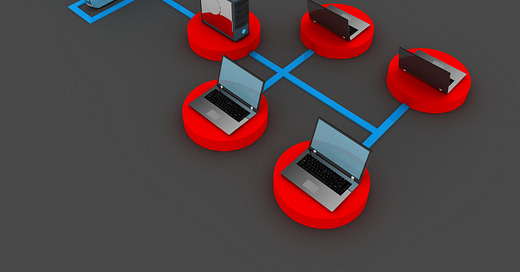Choosing the Right Architecture: Monolithic vs Distributed Systems
Key Differences and Challenges in Modern Software Architecture
Software architecture is the backbone of any application, influencing everything from performance to maintainability. Choosing the right architectural style isn’t just a technical decision—it affects how software evolves over time, how easily it scales, and how efficiently teams can manage it.
Monolithic and distributed architectures represent two different approaches to structuring software. A monolithic architecture consists of a single deployable unit where all components are tightly integrated. This simplicity makes it easier to develop and deploy, but it can become difficult to scale as an application grows.
On the other hand, distributed architectures break an application into multiple independent services that communicate over a network. This approach allows for better scalability and flexibility but introduces challenges such as network latency, service coordination, and security concerns.
The decision between these two models is one of the most fundamental choices in software architecture. The right approach depends on the scale of the application, the expected rate of change, and the operational complexity a team is prepared to manage. In this article, we’ll explore the differences, the challenges associated with each, and key factors to consider when deciding which architecture best fits a project’s needs.
Understanding Monolithic and Distributed Architectures
The structure of an application has a direct impact on how it is built, maintained, and scaled. Two of the most common architectural styles are monolithic and distributed architectures. Each has its strengths and challenges, making it essential to understand their differences before deciding which approach best suits a project.
What is Monolithic Architecture?
A monolithic architecture is built as a single deployable unit where all components are tightly integrated. This means that the user interface, business logic, and database interactions all exist within a single codebase and are deployed together.
Key Characteristics:
A single application runs as one unified process.
All components share the same codebase and are tightly coupled.
Communication between different parts of the application happens within the same runtime environment.
Where Monolithic Architecture is Still Useful:
Small to Medium Applications: Monolithic architectures work well for simple applications with fewer moving parts.
Early-Stage Startups: When speed of development is a priority, keeping everything in a single deployable unit reduces complexity.
Internal Enterprise Applications: Systems with a controlled number of users and predictable load can benefit from the straightforward deployment of a monolithic structure.
Low Operational Overhead: Organisations that want to minimise infrastructure management may prefer a monolithic approach due to its simpler deployment model.
While monolithic architectures can be easier to build and deploy initially, they can become difficult to scale and maintain as an application grows in complexity.
What is Distributed Architecture?
A distributed architecture is composed of multiple independent deployable units, often referred to as services. These services communicate over a network using APIs, messaging queues, or event-driven mechanisms. Unlike monolithic architectures, distributed systems allow for more flexibility and independent scaling of different components.
Key Characteristics:
The application is broken into multiple services or components, each running independently.
Communication between components happens over a network using protocols such as HTTP, gRPC, or message brokers.
Services can be deployed, updated, and scaled independently of each other.
Benefits and Common Use Cases:
Scalability: Distributed architectures allow different components of an application to scale based on demand without affecting the entire system.
Fault Tolerance: If one service fails, it does not necessarily bring down the entire application, improving system reliability.
Technology Flexibility: Different services can be built using different technologies, allowing teams to use the best tool for each part of the application.
Better Maintainability: Teams can work on different services independently, making it easier to update or replace parts of the system.
Distributed architectures are well-suited for large-scale applications, SaaS platforms, and businesses that require high availability and flexibility. However, this approach comes with its own challenges, such as managing service communication, security, and latency, which require careful planning and infrastructure investment.
Understanding the trade-offs between monolithic and distributed architectures is crucial for making informed decisions about software design. The right choice depends on the complexity of the application, scalability needs, and operational constraints.
Key Challenges in Distributed Systems
While distributed architectures offer scalability, flexibility, and resilience, they also introduce challenges that must be carefully managed. Unlike monolithic systems, where all components exist within the same process, distributed systems rely on network communication, external service dependencies, and complex data consistency models.
Below are some of the most significant challenges that come with adopting a distributed architecture and how they can be addressed.
Managing Service Contracts and Versioning
In a distributed system, services communicate through APIs, messaging, or event-driven mechanisms. Each service relies on a contract—a defined structure that determines how data is exchanged.
Key Challenges:
Changing an API without proper versioning can break client integrations.
Clients and services evolve at different speeds, making it difficult to maintain compatibility.
Rolling out updates across multiple dependent services requires careful coordination.
Strategies to Handle Versioning Effectively:
Semantic Versioning (v1, v2, v3) – Ensures backward compatibility while allowing improvements.
API Gateways – Route different API versions to the correct service implementation.
Feature Flags – Introduce new capabilities without forcing immediate changes on clients.
Handling Service Availability and Responsiveness
Distributed architectures depend on multiple independent services working together. If one service is unavailable, it can affect the entire system.
Key Challenges:
A failed service may cause cascading failures if not handled correctly.
Slow responses from one service can degrade the entire application’s performance.
Relying on external dependencies introduces failure points beyond direct control.
Strategies for Improving Availability and Responsiveness:
Circuit Breakers – Automatically disable failing services to prevent cascading failures.
Retry Mechanisms – Automatically retry failed requests within controlled limits.
Timeout Configurations – Set reasonable time limits to avoid waiting indefinitely for unresponsive services.
Failover Mechanisms – Redirect traffic to backup instances when primary services fail.
Dealing with Latency in Distributed Systems
One of the biggest shifts from monolithic to distributed systems is latency. In a monolithic system, function calls happen in-memory and are near-instantaneous. In distributed systems, calls happen over a network, introducing delays.
Key Challenges:
Remote calls take significantly longer than local in-memory method calls.
Latency is unpredictable due to network congestion and variable response times.
Inter-service communication can cause bottlenecks, reducing system performance.
How to Optimise Remote Service Communication:
Reduce Unnecessary API Calls – Minimise the number of inter-service requests.
Batch Processing – Combine multiple small requests into fewer large requests.
Asynchronous Processing – Use message queues to reduce blocking API calls.
Caching Strategies – Store frequently accessed data in-memory to reduce repeated calls.
Security Considerations in Distributed Systems
Security in a distributed system is more complex than in a monolithic system. In a single-process architecture, internal calls are trusted, whereas in a distributed system, every request could come from an untrusted source.
Key Challenges:
Requests between services must be authenticated and authorised.
Attackers can exploit unsecured API endpoints.
Data transmitted between services must be protected from interception.
Best Practices for Securing Distributed Systems:
Authentication & Authorisation – Use OAuth, JWT, or API keys for identity validation.
Encryption – Secure data in transit using TLS/SSL and at rest using strong encryption standards.
API Gateways – Centralise security policies, rate limiting, and request validation.
Zero Trust Architecture – Assume all requests must be verified, even from inside the network.
Distributed Logging and Debugging Complexity
When an issue occurs in a monolithic system, logs are stored in a single place, making it relatively easy to debug. In a distributed system, logs are scattered across multiple services, making troubleshooting far more difficult.
Key Challenges:
Logs are spread across different services and servers.
Tracing a single request through multiple services is difficult.
Finding the root cause of an issue requires stitching logs together manually.
Tools and Strategies for Effective Logging:
Centralised Logging Solutions – Use tools like the ELK Stack (Elasticsearch, Logstash, Kibana) for aggregating logs.
Distributed Tracing – Implement Jaeger or OpenTelemetry to track requests across services.
Correlation IDs – Assign a unique ID to each request, making it easier to trace transactions through multiple services.
Transaction Management in Distributed Systems
In monolithic applications, transactions are handled using ACID (Atomicity, Consistency, Isolation, Durability) principles. However, in a distributed system, maintaining strict ACID transactions across multiple services is impractical due to network delays, failures, and independent service deployments.
Key Challenges:
Distributed transactions cannot be rolled back easily across multiple services.
Ensuring data consistency between different services requires a new approach.
Failures in multi-service transactions can leave data in an inconsistent state.
Alternative Strategies for Managing Transactions:
BASE Transactions (Basic Availability, Soft-state, Eventual Consistency) – Prioritises availability over strict consistency.
Saga Pattern – Splits a transaction into multiple steps, each with a compensating action in case of failure.
Eventual Consistency – Accepts that data consistency might take time but will be resolved asynchronously.
Distributed architectures provide scalability, flexibility, and resilience, but they also introduce complexity in service communication, security, logging, and transaction management.
Before shifting to a distributed system, teams must weigh the benefits against the operational challenges. Success depends on proper planning, the right tooling, and well-defined architecture patterns. By understanding these key challenges and addressing them early, organisations can build reliable, high-performance distributed systems.
Conclusion
Choosing between monolithic and distributed architectures is one of the most important decisions in software design. Each approach comes with its own strengths and challenges, and the right choice depends on the specific needs of the application and business.
Monolithic architectures offer simplicity, faster development, and easier debugging, making them ideal for smaller applications or teams that prioritise quick deployment over flexibility. However, as applications grow, the limitations of a single deployable unit become more apparent, often leading to scaling and maintenance difficulties.
Distributed architectures provide scalability, fault tolerance, and flexibility but introduce challenges such as managing service communication, handling network latency, ensuring security across multiple services, and maintaining distributed logs. These architectures require additional planning, infrastructure, and monitoring to function effectively.
The best approach depends on factors such as team size, system complexity, expected growth, and operational overhead. While monolithic architectures may work well for smaller applications, distributed architectures are often necessary for large-scale systems that require high availability and independent scaling.
As technology and business needs change, architectural decisions should be revisited and refined. What works today may need adjustments tomorrow, and successful architectures evolve alongside the needs of the business. Whether maintaining a monolithic system or transitioning to a distributed model, continuous assessment and adaptation are key to ensuring that the architecture remains effective and aligned with business goals.
For those looking to deepen their expertise in enterprise architecture and elevate their projects through strategic communication, I invite you to connect with me. As an experienced Enterprise Architect and AI consultant, I offer tailored guidance and insights that can transform your architectural practices. Visit my social media profiles to learn more about my services and how I can help you achieve excellence in your architectural endeavours. Let’s build robust, effective solutions together and drive success in your next project. X(twitter), Instagram.
For more articles on ethical AI, Architecture, leadership strategies, and staying technically relevant, follow me on LinkedIn or subscribe to my blog for regular updates.





